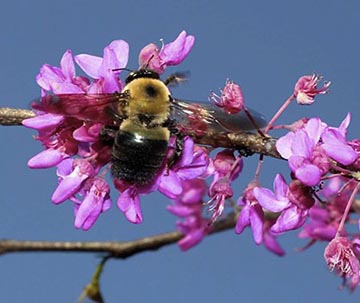The eastern redbud (Cercis canadensis) is a small tree or tall shrub that is native to much of the eastern U.S. In the early spring, redbuds produce clusters of pink flowers. Redbuds bloom before the leaves have started to appear on most trees and their pretty pink flowers can often be spotted in the understory of open forests as you drive along the road. Redbuds are also commonly planted as a popular landscape tree and many ornamental varieties have been developed.

Eastern redbuds are pollinated by many types of bees. Honey bees will gather nectar from redbud flowers; however, they rarely produce enough redbud honey to harvest because redbuds bloom too early in the year. At this time of year, honey bees typically don’t have enough bees in the hive to gather and store harvestable honey. Many native bees also rely heavily on redbud flowers in the early spring. Examples of native bees that gather nectar from redbud flowers and in the process serve as pollinators include: carpenter bees, bumble bees, mason bees, Halictid bees, blueberry bees, and many others.
The flowers produce seed pods in the summer. The seed pods look like clusters of pea pods hanging from the tree. And there is a good reason why redbud seed pods are reminiscent of pea pods – the redbud is in the same family as peas and beans. Some birds will eat the seeds throughout the fall and winter.
Redbud leaves look like green hearts. Several species of moth caterpillars and at least one species of butterfly caterpillar eat redbud leaves. The caterpillar of the redbud leaf-folder moth (Fascista cercerisella) only eats redbud leaves. As its name suggests, this caterpillar folds the redbud leaf and “stiches” the leaf together to create a private hiding place.
The eastern redbud is a beautiful tree that is beneficial to a variety of animals including many species of bees. It is a good option for those who want to plant trees that are good for pollinators, especially bees. I encourage you to enjoy its pretty flowers this spring and to take time to watch the many different species of bees that it attracts.

This article was part of Shannon’s original Kentucky Pollinators and Backyard Wildlife blog which evolved into the blog for Backyard Ecology.

Backyard Ecology: Exploring Nature in Your Backyard
Nature isn’t just “out there.” It’s all around us, including right outside our doors. Hi, my name is Shannon Trimboli, and I am the host of Backyard Ecology. I live in southcentral Kentucky and am a wildlife biologist, educator, author, beekeeper, and owner of a nursery specializing in plants for pollinators and wildlife conservation. I invite you to join me as we ignite our curiosity and natural wonder, explore our yards and communities, and improve our local pollinator and wildlife habitat. Learn more or subscribe to my email list at www.backyardecology.net.

Leave a Reply